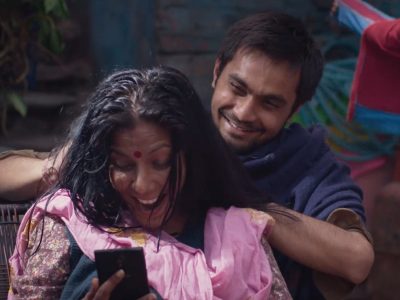In the middle of laughter and intrigue, the theater resonates with the boisterous cry of Eeb Allay Ooo from our protagonist, Anjani Prasad, as he struggles to perfect the distinctive sounds. Anjani finds himself thrust into the role of a monkey repeller, tasked with dispersing the simian inhabitants roaming the streets of the national capital.
Guided by Mahender, a seasoned monkey catcher, Anjani’s initiation into the squad unfolds amidst the watchful eyes of supervisors, setting the stage for the unfolding drama.
Prateek Vats’ directorial debut, “Eeb Allay Ooo” continues to captivate audiences since its release in 2020. Set against the backdrop of the national capital, Delhi, the film intricately explores themes of migration, unemployment, militarisation, and nationalism, resonating with viewers through its grounded narrative.

In a light-hearted jest, Vats chuckles over the phone, “What else could one possibly create on this topic if not a farce?”
Born and raised in Delhi, Vats’ inspiration sparked from a newspaper article discussing the prohibition of langurs, traditional monkey-scaring devices, leading him on a quest to capture the nuances of human-animal conflict in the city. Monkeys evoke a mixed response from Delhi residents, oscillating between fear and fascination.
Drawing from his documentary background, Vats reflects on the challenges of filming wild monkeys, remarking, “Even though the monkey scenes are humorous, these creatures are incredibly unpredictable.” The team faced difficulties sourcing a madari or monkey trainer for the shoot, as nobody was willing to work with untamed primates.
Anjani Prasad finds himself grappling with the complexities of life in Delhi, residing with his sister and brother-in-law, both humorously named Shashi. “We opted for gender-neutral names to allow for creative flexibility,” explains Vats. Recently employed as a monkey catcher, the film delves into our protagonist’s humorous yet desperate attempts to outwit the relentless monkeys of Rashtrapati Bhavan.
With poignant cinematography capturing Delhi’s power hubs like the Parliament and Secretariat juxtaposed against the struggles of living on the city’s outskirts, the movie serves as a poignant commentary on rampant unemployment. “I refuse to be stuck in this job; I’ll find something else,” declares Anjani in the film, despite his educational qualifications only stretching to 11th grade.

Vats underscores the film’s exploration of caste dynamics, revealing, “We envisioned the brother-in-law belonging to a different caste, examining how that influences career choices.” Through Anjani’s journey, the movie navigates the intricate interplay of societal norms and personal aspirations.
The film also offers commentary on the portrayal of weapons, as Shashi, a security guard, reluctantly accepts a rifle and a raise of Rs 1500. Unsettled by the idea of bringing a gun into his home, Shashi ultimately acquiesces, driven by impending fatherhood. “We often see weapons depicted as symbols of machismo; we aimed to challenge that narrative,” explains the director.
Amid the backdrop of contractual labour’s anxiety-ridden world, characterised by instability and irregular income, Anjani employs every tactic imaginable. From utilising recorded noises to donning a langur costume himself.
The screening of the movie at Delhi’s Alliance Française, organised by artist collective W.I.P labs, drew audiences into the mesmerising cinematography of Saumyananda Sahi. “We aimed for a sensitive portrayal of the issue, incorporating and navigating the movement of monkeys,” notes Vats.
Vats emphasises that no sound dubbing was employed, with the sound team meticulously capturing natural ambiences. Mahinder, a pivotal figure in the film, is portrayed by his real-life counterpart, a seasoned monkey catcher. “We aimed to involve individuals immersed in this reality,” Vats explains.
Omar (26), a Kashmiri viewer in the audience, reflects, “I found the movie to be primarily about jobs, or the lack thereof, and how a family struggles to survive in these challenging times.”
Sayyam Jain, an undergraduate student, and aspiring filmmaker, appreciated “how it explored the theme of violence.”

Despite its availability on Netflix, the theatrical release of the film in 2020 continues to attract audiences to screenings. Vats explains, “We opted for a theatrical screening because we believe cinema should be a communal experience. Every filmmaker desires a discussion about their work, and screening it in theaters allows audiences to truly appreciate its intricacies.”
Anirban Ghosh of W.I.P Labs states, “We chose to screen this film because we advocate for alternatives and aim to foster a community that not only values genuine cinema but also supports independent artists and creators.”
Speaking on whether the film falls into the category of absurdist cinema, Anant from the artist collective remarks, “The reality of modern India is inherently absurd. We’re grappling with issues like attempting to open Tesla factories while neglecting basic sanitation practices, risking human lives in sewer cleaning. Vats astutely utilises an absurd ‘job,’ grounded in reality.”





